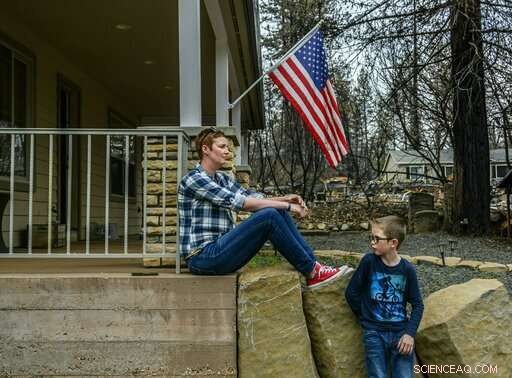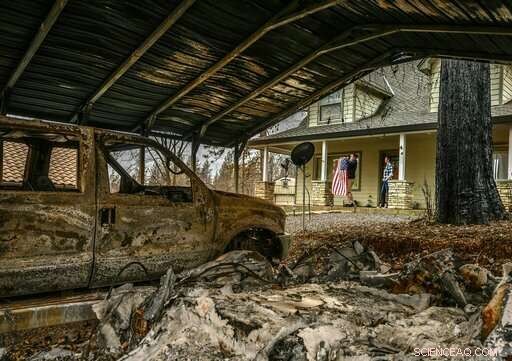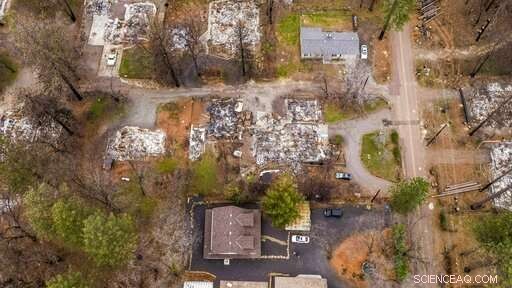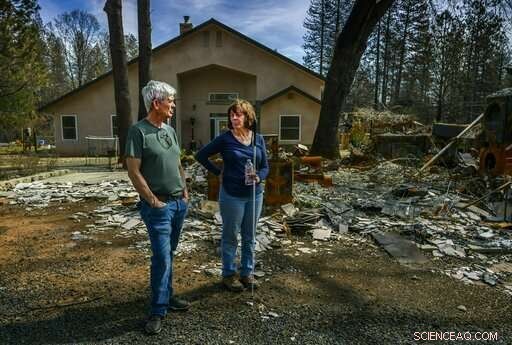
Sur cette photo prise le 19 mars, 2019, Dawn Herr et son fils Liam, 8, visiter leur maison au paradis, Californie, qui a survécu au feu de camp. La maison des Herrs, construit en 2010, a été brûlé et a subi des dommages causés par la fumée à l'intérieur, de sorte que la famille vit temporairement à Chico, à proximité. Les Herr attribuent la survie de la maison aux codes du bâtiment stricts et au gravier qui entourait le bâtiment et empêchait les flammes. (Hector Amezcua/L'abeille de Sacramento via AP)
Le ciel devenait orange et les braises volaient du feu de camp lorsque Oney et Donna Carrell et le père de Donna se sont enfuis de leur maison paradisiaque.
"Je pensais, 'Oh, bien, la maison est faite, '", a déclaré Oney Carrell.
Quelques jours plus tard, ils ont appris le contraire. La maison des Carrell a survécu à l'incendie de forêt le plus meurtrier et le plus destructeur de l'histoire de la Californie avec quelques cadres de fenêtres déformés, un bec partiellement carbonisé et une odeur de fumée tenace à l'intérieur.
La plupart de leur quartier a été détruit. Une maison d'hôtes dans leur arrière-cour, où vivait le père de Donna, a été réduit en cendres, avec quelques hangars. Pourtant, leur Studebaker 1940 magnifiquement restaurée était restée intacte dans le garage.
L'arc de destruction que le feu de camp a sculpté à travers le paradis était apparemment aléatoire :pourquoi certaines maisons ont-elles été sauvées et d'autres incinérées ? Alors que des millions de Californiens se préparent pour une autre saison de feux de forêt, une analyse McClatchy des dossiers d'incendie et de propriété montre que la réponse pourrait être trouvée dans quelque chose d'aussi simple que les toits au-dessus de leurs têtes et l'année de construction de leur maison.
Un code du bâtiment emblématique de 2008 conçu pour les régions californiennes sujettes aux incendies, nécessitant des toits résistants au feu, voie d'évitement et autres mesures de protection - semble avoir protégé la maison des Carrell et des dizaines d'autres du même type du feu de camp. Cette année marque un moment charnière dans l'histoire meurtrière et coûteuse de l'État en matière de catastrophes naturelles destructrices.
En tout, environ 51 pour cent des 350 maisons unifamiliales construites après 2008 sur le chemin de l'incendie de camp n'étaient pas endommagées, selon l'analyse de McClatchy des données de Cal Fire et des dossiers de propriété du comté de Butte. Par contre, seulement 18 pour cent des 12, 100 maisons construites avant 2008 ont échappé aux dommages. Ces chiffres n'incluent pas les mobil-homes, qui a brûlé dans une mesure presque égale quel que soit l'âge.
"Ce sont d'excellentes normes ; elles fonctionnent, " a déclaré l'ingénieur principal Robert Raymer de la California Building Industry Association, qui a consulté des représentants de l'État sur le code du bâtiment.
Pourtant, malgré cette leçon, La Californie pourrait finir par échouer dans ses efforts pour protéger les maisons du prochain incendie de forêt.
Des villes champignons telles que Folsom, où un 11, Le développement de 000 logements se développe, ont la capacité de contourner les normes de sécurité de l'État malgré des risques d'incendie considérables. L'état, qui offre des incitations financières pour renforcer les vieilles maisons contre les tremblements de terre, jusqu'à présent, n'a rien fait pour amener les Californiens à rénover les maisons construites avant 2008 pour la sécurité incendie.
Cela n'a pas aidé que la construction de logements soit entrée dans une plongée profonde en 2008 et ait été lente à se redresser. Raymer a dit seulement 860, 000 maisons et appartements ont été construits dans tout l'État depuis l'entrée en vigueur du code. Cela ne représente que 6 % du parc immobilier de l'État.
Selon Cal Fire, jusqu'à 3 millions de foyers se trouvent dans les diverses « zones de gravité des risques d'incendie » autour de l'État. Dave Sapsis, un scientifique des feux de forêt de Cal Fire, dit qu'il n'y a aucun moyen de savoir avec certitude combien de ces maisons ont été construites avant 2008, mais il croit "c'est la prépondérance d'entre eux, la majorité."
La situation est pire dans la Californie rurale, où la construction de logements est à la traîne mais les risques d'incendie sont parmi les pires de l'état, dit Raymer. Moins de 3 % des maisons sur le chemin du feu de camp ont été construites après 2008.
"La plupart de notre inventaire qui était ici avant l'incendie a été (construit) entre les années 40 et les années 70, " a déclaré le conseiller municipal de Paradise Michael Zuccolillo, un agent immobilier. "La maison moyenne ici date des années 70."
Cela laisse des milliers de maisons menacées par le prochain enfer à travers la Californie, leurs bardeaux de bois ne tardaient pas à s'enflammer.
« Qu'allons-nous faire du parc de logements existant qui a été construit dans ces endroits ? » dit Max Moritz, un spécialiste des incendies de forêt à l'UC Santa Barbara. « Pour le parc immobilier existant, qui n'est pas construit selon ces codes, nous avons un énorme problème de modernisation sur nos mains. Ils ont des vulnérabilités d'allumage de structure qui sont intégrées à la situation, ils sont plongés dans le problème."
'Le maillon faible'
Les Carrell, vivant maintenant dans une location à Roseville, conçu leur maison paradisiaque et fait eux-mêmes une grande partie des travaux intérieurs; ils savaient que la maison avait été construite en tenant compte de la sécurité incendie.
"Je savais que nous étions au milieu de la forêt, " Oney Carrell a déclaré lors d'une récente visite au paradis. "Pourquoi ne feriez-vous pas tout votre possible pour que cela dure?"
Mais même lui est étonné que leur maison l'ait fait. Enjambant un drain de patio noirci à quelques mètres de l'arrière de la maison, il se demanda à haute voix :« Je ne sais pas pourquoi ça s'est arrêté ici.
Il est presque impossible de dire avec certitude pourquoi certaines maisons sont encore debout au paradis, tandis que d'autres ont été ruinés. L'aménagement paysager a sûrement joué un rôle; Les experts en incendie affirment que les maisons protégées par un "espace défendable" ont probablement mieux fonctionné que celles enveloppées d'arbustes. La chance était un facteur important, trop, car les maisons ont sans aucun doute été épargnées par les changements de vent de dernière seconde.
Néanmoins, les experts disent, L'analyse de McClatchy renforce leur conviction que le code du bâtiment californien anti-incendie peut faire la différence dans une ère de vulnérabilité croissante. Daniel Gorham, un ancien pompier et chercheur du Service forestier des États-Unis qui travaille pour l'Insurance Institute for Business &Home Safety en Caroline du Sud, a déclaré que le code californien devient un modèle pour d'autres États sujets aux incendies.
"La Californie a une longueur d'avance sur les autres régions du pays, " a déclaré Gorham. " La Californie est à l'avant-garde. "
Les partisans disent que les matériaux de construction résistants au feu ne sont pas particulièrement chers. Une étude réalisée l'automne dernier par Headwater Economics, a consulting firm in Bozeman, Mont., found that "a new home built to wildfire-resistant codes can be constructed for roughly the same cost as a typical home."

In this March 19, 2019, Sean and Dawn Herr collect an American flag that survived the Camp Fire along with their Paradise, Californie, domicile. The Herrs' home, built in 2010, was scorched and had smoke damage inside so the family is living indefinitely in nearby Chico. The Herrs credit the home's survival to strict building codes and to gravel that encircled the building and kept the flames back. (Hector Amezcua/The Sacramento Bee via AP)
But getting Californians to retrofit homes built before 2008 is an enormous task. The state requires property owners in fire zones who replace at least half their roof to install "fire-retardant" materials on the entire roof. Autre que ça, cependant, there's nothing forcing Californians to safeguard their existing homes against fire hazards.
A few California cities have taken matters into their own hands. In 2008, the City Council in Big Bear Lake, a community of 5, 200 in San Bernardino County, passed an ordinance declaring wood shake shingle roofs "a severe fire hazard and danger" and ordered homeowners to replace them by 2012. Armed with state and federal grants, it offered cash incentives of up to $4, 500 apiece for new roofs.
Although the grant program has run out, "I can't think of the last time I saw a shake roof in Big Bear, " said Patrick Johnston, the city's chief building official.
Most Californians, cependant, are on their own when it comes to spending the tens of thousands of dollars needed to replace a roof or install fire-resistant siding. The state offers no financial incentives for fire safety the way it does, dire, for earthquakes—homeowners in quake zones can get up to $3, 000 apiece from the state to gird their homes against seismic disaster.
There are signs, cependant, that the state is beginning to get more serious about retrofitting homes for fire safety.
A law signed last year by former Gov. Jerry Brown requires the state fire marshal to develop a suggested list of "low-cost retrofits" by January 2020. The state would then promote these retrofits in its education and outreach efforts.
California also might start throwing cash at the problem.
A new bill, AB 38, introduced earlier this year by Democratic Assemblyman Jim Wood of Santa Rosa, would create a $1 billion "fire hardened homes revolving loan fund" to help homeowners retrofit their properties.
The issue is personal for Wood, a dentist who spent weeks helping identify victims from the Camp Fire and the wine country fires of October 2017. Although eligibility terms haven't been spelled out, the bill would offer low-interest and no-interest loans to help those who otherwise couldn't pay for new roofs or other safeguards.
"A lot of these small towns are not as well off financially, " he said. "We need to find a way to help them, especially if they're poorer."
The fund might not be nearly enough to go around—not with hundreds of thousands of homes in need of retrofits, and a new roof alone costing $10, 000 or more. "The $1 billion, En effet, that's not enough to rehab every home, " said the Building Industry Association's Raymer. But he said it's "an absolutely excellent way to kick things off."
Wood said state officials would have to figure out a plan for parceling out the money to where it's needed most—probably starting with lower-income areas near forests.
"Obviously we want to affect the areas with the highest risk first, " the assemblyman said. "A lot of these small towns are not as well off financially. We need to find a way to help them, especially if they're poorer."
Mapping 'Severity Zones'
The fire-safe building code had its origins in two significant fires from a generation ago—the Panorama Fire of 1980, which spilled out of the mountains into the city of San Bernardino; and the monstrous Oakland Hills Fire of 1991, which wiped out 2, 500 homes and killed 25 people.
In response, the Legislature ordered the Department of Fire Protection and Forestry to start mapping major fire risks in California, in the hinterlands as well as urban areas. The result was a collection of maps of the state's "fire hazard severity zones, " encompassing more than one-third of California's land mass.
Based on factors such as terrain, vegetation and weather patterns, the zones represent Cal Fire's attempt to predict the probability of a fire starting and the likelihood that it could become significant, said Cal Fire's Sapsis.
The maps spawned tighter building standards. The Legislature mandated fire-resistant roofs in these fire-prone areas. Then in 2008 the state laid out a more comprehensive scheme. The California Building Standards Commission rolled out a suite of regulations, known as Chapter 7A, that set strict rules for roofing materials, siding, windows, decks and other elements of a home built in 2008 or later—right down to the minimum specs for the wire mesh that must be installed on attic vents to keep embers out (no more than a quarter-inch of space between the wires).
Experts said the regulations seem to be particularly effective at protecting structures from the types of wildfires that are increasingly common in California, where wind gusts can blow embers a mile or two ahead of the main wall of flames and do some of the worst damage.
"A window breaks, a vent breaks, the fire gets into your home and you've got an interior structure fire, " said Joe Poire, the city of Santa Barbara's fire marshal.
Enforcement of the building code carries a few wrinkles. In the mainly rural areas where Cal Fire is in charge of fire protection, the Chapter 7A code is automatically enforced in any region that Cal Fire has designated as a "severity zone"—moderate, high or very high.
In urban areas that have their own fire departments, the code is generally used only in spots where Cal Fire says the threat is very high. Local governments have the discretion of rejecting the Cal Fire designation, and Sapsis said some city councils have been squeamish about the state's maps because of fears that the Chapter 7A code will inflate construction costs, or for other reasons.
Yet interviews with local officials throughout California by McClatchy indicate that the vast majority of cities and towns go along with Cal Fire's recommendations. Santa Barbara city officials extended the building code to coastal areas that had been overlooked by Cal Fire's mappers. The map omits small portions of Paradise, but the building code is enforced across the entire town, said Paradise public information officer Colette Curtis.

In this March 19, 2019 photo, an aerial image shows the home of Sean and Dawn Herr, bottom center, au paradis, Calif. The Herr home, built in 2010 to new fire-resistant building standards, survived the fire while nearby homes burned. (Hector America/The Sacramento Bee via AP)
Danger In Santa Rosa, Folsom?
Néanmoins, there are places where local officials are reluctant to impose strict building codes—even where fire has caused catastrophe.
Before Paradise exploded, Santa Rosa's Coffey Park was the poster child for recent California wildfire disasters:Five people died and 1, 321 homes were destroyed by the Tubbs Fire in October 2017.
Coffey Park wasn't subject to California's Chapter 7A building code. It still isn't.
Unlike some areas of Santa Rosa, the neighborhood hasn't been designated a "very high fire hazard" zone by Cal Fire. City officials are OK with that. Although developers rebuilding Coffey Park are being urged to consider fire-resistant materials, city spokeswoman Adriane Mertens said the city doesn't see any reason to impose the 7A code in the neighborhood.
"There were very, very high winds that night, " Mertens said. "There were embers that were blown across the (Highway 101) freeway, across six lanes of freeway, into Coffey Park."
Jack Cohen, a fire scientist in Montana who helped develop the 7A code, said he thinks Santa Rosa is committing "an error in judgment" by rebuilding without the safeguards.
In any event, Cal Fire is updating its fire hazard maps over the next year or so, taking into account more sophisticated data on wind and other climate factors, and Sapsis said spots such as Coffey Park could wind up designated as high-risk areas. Once the maps are done, any region placed inside Cal Fire's "very high fire" zone will have no choice but to comply, under a bill signed into law by Brown last year.
But there will still be ways for cities to skirt the state building code.
Look at Folsom, widely considered one of the most vulnerable places in greater Sacramento to fire. The county's hazard mitigation plan says 44, 000 residents of Folsom are already at "moderate or higher wildfire risk."
Now the suburb is building a development called Folsom Ranch, eventually to be home to 25, 000 personnes, on a parcel south of Highway 50.
The development is on land that used to be subject to the strict state building code. Now it isn't.
Comment est-ce arrivé? Years ago, the land was outside Folsom's city limits and Cal Fire was responsible for its safety. Cal Fire's maps put the land in the "moderate" risk zone—a threat level high enough that, under the state's regulations, the fire-safe building code took effect. As it happened, no construction took place during that time, city officials say.
The situation changed when the city annexed the land to forge ahead with Folsom Ranch. Because the land has never been in the state's "very high" risk zone, the city feels comfortable letting Folsom Ranch develop without the Chapter 7A building code.
Fire Chief Felipe Rodriguez said Folsom officials are still open to "the possibility of strengthening, hardening, our future homes." But for now, the city is only requiring homeowners' associations to implement a "vegetation management" plan and install fire-resistant fencing around properties that abut open space areas, Rodriguez said.
Is Folsom courting danger? Rodriguez doesn't think so. The city will build two fire stations in the development and will "be able to suppress a fire during its early stages, " il a dit.
'Sticks In A Fireplace'
The hundreds of thousands of older homes in fire zones aren't just more vulnerable in their own right.
Experts say they spread danger to new homes built to stricter standards.
"One little house built to a new standard, surrounded by a bunch of older stuff, is likely to get swamped, " Sapsis said.
Paradise provided a grim reminder of that problem. The Camp Fire destroyed more than 80 percent of the 4, 100 mobile homes in its path, whether they were built to the new code or not, according to McClatchy's data analysis. That isn't surprising, Sapsis said, given that many of Paradise's mobile homes were jammed alongside one another in mobile home parks.
"They're stacked so close together, they're like sticks in a fireplace, " Sapsis said.
Sapsis and others say the lesson is that strong building codes aren't enough. En particulier, experts say communities must pay more attention to how they lay out their neighborhoods, allowing for firebreaks and enough space between houses.
"In the name of affordable housing, we're moving housing closer and closer to one another, " said Chris Dicus, a forestry and fire expert at Cal Poly, San Luis Obispo. "That serves to have house-to-house-to-house ignition."

In this March 19, 2019 photo, Oney and Donna Carrell stand near the ashes of her father's house in Paradise, Calif. Their property had two homes on it before the fire, but the only one to survive visible behind them was built to fire-resistant standards that went into effect in 2008. (Hector Amezcua/The Sacramento Bee via AP)
The problem isn't limited to densely-packed urban areas. "I live in a rural community, and I have got six feet basically separating me from my neighbor, " said Dicus, who lives outside of Morro Bay.
En outre, experts say California is struggling to enforce the state law regarding "defensible space" around properties.
The law requires that property owners maintain as much as 100 feet of defensible space around homes and other buildings in and around "a mountainous area, forest-covered lands, brush-covered lands, grass-covered lands, or land that is covered with flammable material." That means keeping trees and shrubs pruned and spaced far apart. Within five feet of the building, property owners are supposed to remove anything that could catch fire:mulch, les plantes, woodpiles and so on.
En pratique, cependant, enforcement of the defensible space law has been spotty at best. Raymer, of the California Building Industry Association, said most property owners don't understand how to maintain their yards. The state doesn't impose penalties for non-compliance, and only a few local governments have chosen to do so, Raymer said.
Legislation could change that. SB 190, by Sen. Bill Dodd, D-Napa, would require the state fire marshal to develop a "model defensible space program, " including penalties, that local governments could adopt.
The problem extends beyond homeowners' property lines. Gov. Gavin Newsom, finding some rare common ground with the Trump administration, is advocating for more aggressive management of forested lands.
A thinned forest northeast of Paradise provided one of the rare victories of the Camp Fire. As the fire raged out of the tiny community of Pulga, it essentially spared the northern part of Magalia. The reason was a series of forest-thinning projects conducted in recent years and overseen by the U.S. Forest Service, Sierra Pacific Industries and the volunteer Butte County Fire Safe Council. The council also worked diligently with area residents to clear brush from their property.
All that work "did exactly what we hoped it would do, " said Calli-Jane DeAnda, executive director of the council, which secured $1 million in grants to remove fuels from forested areas. "This investment of public money is so worth the effort."
The Paradise 'Lab Experiment'
The rebuilding of Paradise means thousands of homes are going to be constructed in the coming years to the stricter standards promulgated by the state in 2008. It represents the single largest test of the effectiveness of the building code.
"That is an absolute lab experiment for us, " Sapsis said.
On the streets of Paradise, bien que, community leaders are taking a more measured view. Zuccolillo, the town councilman, said asphalt roofs and stucco siding might "give us more of a chance" but he doubts they will guarantee Paradise's safety.
"I saw metal buildings, metal and stucco buildings, burn to the ground, " il a dit.
Toujours, there's plenty of evidence, all over Paradise, that the state's building code can protect property.
The other day, Sean Herr pulled into his driveway on the west side of Paradise, where he and his wife Dawn were raising their two young children.
The first thing he did was bring out the ultimate symbol of resiliency:an American flag, the same one that flew on his front porch the day of the Camp Fire.
Like the flag, the house is still standing. The Herrs' home, built in 2010, suffered a bit of scorching and some interior smoke damage—the smoke is bad enough that they're still temporarily living in Chico and aren't certain they'll move back.
Toujours, they marvel at what a close call they had. A Ford Excursion and a boat parked in the front yard, just a few feet from their porch, were destroyed. Five motorcycles locked in a shed behind the house got ruined. Most of their neighborhood is gone.
The Herrs believe their attention to defensible space—the house is mostly encircled in gravel—and the strictness of the building code probably made the difference.
"Our yard and the construction of the house saved it for sure, " Dawn Herr said, gesturing to a small scorch mark by the side of the house. "You can see it tried to catch on fire."
© 2019 La Presse Associée. Tous les droits sont réservés.